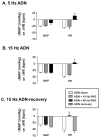Midbrain modulation of the cardiac baroreflex involves excitation of lateral parabrachial neurons in the rat
- PMID: 17355874
- PMCID: PMC1904493
- DOI: 10.1016/j.brainres.2007.01.140
Midbrain modulation of the cardiac baroreflex involves excitation of lateral parabrachial neurons in the rat
Abstract
Activation of the dorsal periaqueductal gray (PAG) evokes defense-like behavior including a marked increase in sympathetic drive and resetting of baroreflex function. The goal of this study was to investigate the role of the lateral parabrachial nucleus (LPBN) in mediating dorsal PAG modulation of the arterial baroreflex. Reflex responses were elicited by electrical stimulation of the aortic depressor nerve (ADN) at 5 Hz or 15 Hz in urethane anesthetized rats (n=18). Electrical stimulation of the dorsal PAG at 10 Hz did not alter baseline mean arterial pressure (MAP) but did significantly attenuate baroreflex control of heart rate (HR) evoked by low frequency ADN stimulation. Alternatively, 40 Hz dorsal PAG stimulation increased baseline MAP (43+/-3 mm Hg) and HR (33+/-3 bpm) and attenuated baroreflex control of HR at both ADN stimulation frequencies. Reflex control of MAP was generally unchanged by dorsal PAG stimulation. Bilateral inhibition of neurons in LPBN area (n=6) with muscimol (0.45 nmol per side) reduced dorsal PAG-evoked increases in MAP and HR by 50+/-4% and 95+/-4%, respectively, and significantly reduced, but did not completely eliminate dorsal PAG attenuation of the cardiac baroreflex. Bilateral blockade of glutamate receptors in the LPBN area (n=6) with kynurenic acid (1.8 nmol) had a similar effect on dorsal PAG-evoked increases in MAP, HR and cardiac baroreflex function. Reflex control of MAP was unchanged with either treatment. These findings suggest that the LPBN area is one of several brainstem regions involved in descending modulation of the cardiac baroreflex function during defensive behavior.
Figures






Similar articles
-
Target site of inhibition mediated by midbrain periaqueductal gray matter of baroreflex vagal bradycardia.J Neurophysiol. 1993 Dec;70(6):2205-14. doi: 10.1152/jn.1993.70.6.2205. J Neurophysiol. 1993. PMID: 7907131
-
Parabrachial neurons mediate dorsal periaqueductal gray evoked respiratory responses in the rat.J Appl Physiol (1985). 2004 Mar;96(3):1146-54. doi: 10.1152/japplphysiol.00903.2003. Epub 2003 Oct 31. J Appl Physiol (1985). 2004. PMID: 14594859
-
Increased c-Fos expression in select lateral parabrachial subnuclei following chemical versus electrical stimulation of the dorsal periaqueductal gray in rats.Brain Res. 2003 Jun 6;974(1-2):153-66. doi: 10.1016/s0006-8993(03)02573-3. Brain Res. 2003. PMID: 12742633
-
Functional specializations within the tectum defense systems of the rat.Neurosci Biobehav Rev. 2005;29(8):1279-98. doi: 10.1016/j.neubiorev.2005.05.006. Epub 2005 Aug 8. Neurosci Biobehav Rev. 2005. PMID: 16087233 Review.
-
Midbrain control of breathing and blood pressure: The role of periaqueductal gray matter and mesencephalic collicular neuronal microcircuit oscillators.Eur J Neurosci. 2020 Oct;52(8):3879-3902. doi: 10.1111/ejn.14727. Epub 2020 May 1. Eur J Neurosci. 2020. Retraction in: Eur J Neurosci. 2021 Oct;54(7):6685. doi: 10.1111/ejn.15484. PMID: 32227408 Retracted. Review.
Cited by
-
Blocking glutamate receptors in the waist area of the parabrachial nucleus decreases taste reactivity behaviors in conscious rats.Chem Senses. 2009 Mar;34(3):221-30. doi: 10.1093/chemse/bjn081. Epub 2009 Jan 27. Chem Senses. 2009. PMID: 19174448 Free PMC article.
-
Distribution of angiotensin type 1a receptor-containing cells in the brains of bacterial artificial chromosome transgenic mice.Neuroscience. 2012 Dec 13;226:489-509. doi: 10.1016/j.neuroscience.2012.08.039. Epub 2012 Aug 23. Neuroscience. 2012. PMID: 22922351 Free PMC article.
-
Comparison of somatostatin and corticotrophin-releasing hormone immunoreactivity in forebrain neurons projecting to taste-responsive and non-responsive regions of the parabrachial nucleus in rat.Brain Res. 2009 Nov 17;1298:57-69. doi: 10.1016/j.brainres.2009.08.038. Epub 2009 Aug 21. Brain Res. 2009. PMID: 19699720 Free PMC article.
-
Orexins and the cardiovascular events of awakening.Temperature (Austin). 2017 Feb 16;4(2):128-140. doi: 10.1080/23328940.2017.1295128. eCollection 2017. Temperature (Austin). 2017. PMID: 28680929 Free PMC article. Review.
-
Distribution of estrogen receptor β containing cells in the brains of bacterial artificial chromosome transgenic mice.Brain Res. 2010 Sep 10;1351:74-96. doi: 10.1016/j.brainres.2010.06.038. Epub 2010 Jun 22. Brain Res. 2010. PMID: 20599828 Free PMC article.
References
-
- Bandler R, Shipley MT. Columnar organization in the midbrain periaqueductal gray: Modules for emotional expression? Trends Neurosci. 1994;17:379–389. - PubMed
-
- Bandler R, Carrive P. Integrated defence reaction elicited by excitatory amino acid microinjection in the midbrain periaqueductal grey region of the unrestrained cat. Brain Res. 1988;439:95–106. - PubMed
-
- Bandler R, Prineas S, McCulloch B. Further localization of midbrain neurones mediating the defense reaction in the cat by microinjections of excitatory amino acids. Neurosci Letters. 1985;56:311–316. - PubMed
-
- Cameron AA, Khan IA, Westlund KN, Willis WD. The efferent projections of the periaqueductal gray in the rat: a phaseolus vulgaris-leucoagglutinin study. II Descending Projections. J Comp Neurol. 1995;351:585–601. - PubMed
-
- Carrive PSP, Karli P. Flight induced by microinjection of D-tubocurarine or alpha-bungarotoxin into medial hypothalamus or periaqueductal gray matter: cholinergic or GABAergic mediation? Behav Brain Res. 1986;22 - PubMed
Publication types
MeSH terms
Substances
Grants and funding
LinkOut - more resources
Full Text Sources
Miscellaneous

